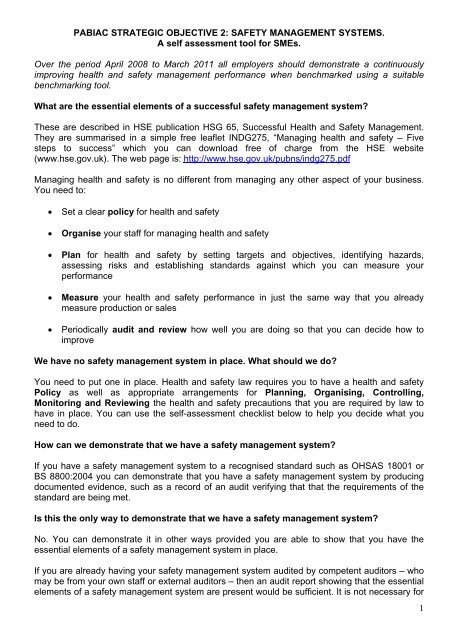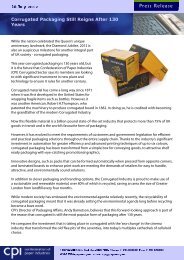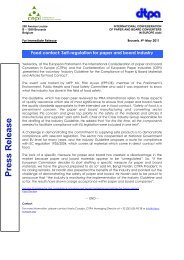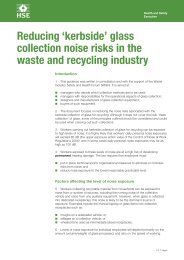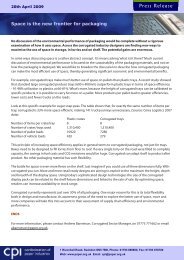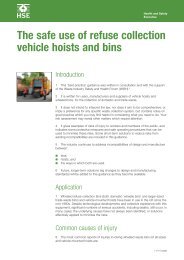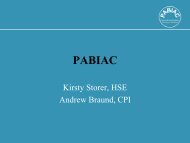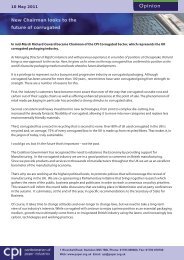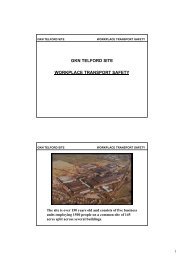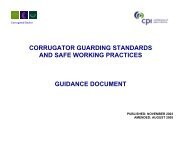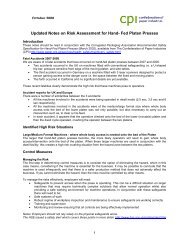safety management systems. a
safety management systems. a
safety management systems. a
Create successful ePaper yourself
Turn your PDF publications into a flip-book with our unique Google optimized e-Paper software.
PABIAC STRATEGIC OBJECTIVE 2: SAFETY MANAGEMENT SYSTEMS.<br />
A self assessment tool for SMEs.<br />
Over the period April 2008 to March 2011 all employers should demonstrate a continuously<br />
improving health and <strong>safety</strong> <strong>management</strong> performance when benchmarked using a suitable<br />
benchmarking tool.<br />
What are the essential elements of a successful <strong>safety</strong> <strong>management</strong> system?<br />
These are described in HSE publication HSG 65, Successful Health and Safety Management.<br />
They are summarised in a simple free leaflet INDG275, “Managing health and <strong>safety</strong> – Five<br />
steps to success” which you can download free of charge from the HSE website<br />
(www.hse.gov.uk). The web page is: http://www.hse.gov.uk/pubns/indg275.pdf<br />
Managing health and <strong>safety</strong> is no different from managing any other aspect of your business.<br />
You need to:<br />
• Set a clear policy for health and <strong>safety</strong><br />
• Organise your staff for managing health and <strong>safety</strong><br />
• Plan for health and <strong>safety</strong> by setting targets and objectives, identifying hazards,<br />
assessing risks and establishing standards against which you can measure your<br />
performance<br />
• Measure your health and <strong>safety</strong> performance in just the same way that you already<br />
measure production or sales<br />
• Periodically audit and review how well you are doing so that you can decide how to<br />
improve<br />
We have no <strong>safety</strong> <strong>management</strong> system in place. What should we do?<br />
You need to put one in place. Health and <strong>safety</strong> law requires you to have a health and <strong>safety</strong><br />
Policy as well as appropriate arrangements for Planning, Organising, Controlling,<br />
Monitoring and Reviewing the health and <strong>safety</strong> precautions that you are required by law to<br />
have in place. You can use the self-assessment checklist below to help you decide what you<br />
need to do.<br />
How can we demonstrate that we have a <strong>safety</strong> <strong>management</strong> system?<br />
If you have a <strong>safety</strong> <strong>management</strong> system to a recognised standard such as OHSAS 18001 or<br />
BS 8800:2004 you can demonstrate that you have a <strong>safety</strong> <strong>management</strong> system by producing<br />
documented evidence, such as a record of an audit verifying that that the requirements of the<br />
standard are being met.<br />
Is this the only way to demonstrate that we have a <strong>safety</strong> <strong>management</strong> system?<br />
No. You can demonstrate it in other ways provided you are able to show that you have the<br />
essential elements of a <strong>safety</strong> <strong>management</strong> system in place.<br />
If you are already having your <strong>safety</strong> <strong>management</strong> system audited by competent auditors – who<br />
may be from your own staff or external auditors – then an audit report showing that the essential<br />
elements of a <strong>safety</strong> <strong>management</strong> system are present would be sufficient. It is not necessary for<br />
1
you to show that your <strong>safety</strong> <strong>management</strong> system is perfect or best in class. PABIAC strategic<br />
objective 2 does, however, require employers to show that their <strong>systems</strong> are continuously<br />
improving.<br />
You can use the self assessment checklist below to help. It is unlikely that any one person in<br />
your business will be able to answer all the questions. You will need to involve your<br />
<strong>management</strong> team and consult your workforce, including any employee and <strong>safety</strong><br />
representatives, when you answer the questions.<br />
Of course, simply having a <strong>safety</strong> <strong>management</strong> system in place does not guarantee success in<br />
managing health and <strong>safety</strong>. Nor does it mean you are complying with all requirements of health<br />
and <strong>safety</strong> law. Everything depends on how your <strong>safety</strong> <strong>management</strong> system operates in<br />
practice and that will depend on many factors including: <strong>management</strong> leadership; effective<br />
implementation of <strong>safety</strong> processes and procedures; continuously improving assessment of<br />
hazard and risks, followed by enhanced controls; use of communication and consultation<br />
processes that develop ownership at all levels in the business: and all these supported by<br />
monitoring, review and improvement of the <strong>systems</strong>.<br />
How do we know how well we are managing health and <strong>safety</strong>?<br />
You can benchmark yourselves against other employers using the Health and Safety<br />
Performance Indicator for small and medium size enterprises. This is available free of charge at<br />
the Business Link website (www.businesslink.gov.uk/). See web page: www.hspi.infoexchange.com.<br />
You can use it to see how well you are doing compared with other businesses in<br />
your industry as well as to check your own progress over time. You put in your own information<br />
by answering some simple questions. This takes about 15 minutes. The answers you give<br />
remain anonymous and confidential. Nobody else can see your results. But you can see the<br />
collective results for all businesses using the indicator and compare your own score with the rest<br />
of your industry.<br />
As with any business system it takes time to build a successful health and <strong>safety</strong> <strong>management</strong><br />
system and then to fine-tune it so that it continues to deliver satisfactory standards of health and<br />
<strong>safety</strong> at work. You can use the performance indicator to see where you are now and to check<br />
your progress at appropriate intervals.<br />
You can assess your own health and <strong>safety</strong> <strong>management</strong> system using the following self<br />
assessment checklist. By using the columns on the right of the table you can give yourself a<br />
score for each element. By repeating this exercise after you have made improvements to your<br />
<strong>safety</strong> <strong>management</strong> system you can check your progress over time.<br />
Self assessment Checklist<br />
POLICY<br />
Fully<br />
met<br />
Partially<br />
met<br />
Not met<br />
at all<br />
1. The company has a clear, written policy for health and <strong>safety</strong> at work,<br />
signed, dated and communicated to all employees?<br />
2. The Directors regard health and <strong>safety</strong> of employees as an important<br />
business objective?<br />
3. The Directors are committed to continuous improvement in health and<br />
<strong>safety</strong> (reducing the number of injuries, cases of work-related ill health,<br />
absences from work and accidental loss)?<br />
(score 2)<br />
(score 1)<br />
(score 0)<br />
2
4. A named Director or Senior Manager has been given overall responsibility<br />
for implementing our health and <strong>safety</strong> policy?<br />
5. Our policy commits the Directors to preparing regular health and <strong>safety</strong><br />
improvement plans and regularly reviewing the operation of our health and<br />
<strong>safety</strong> policy?<br />
6. Our policy encourages the involvement of employees and <strong>safety</strong><br />
representatives in the health and <strong>safety</strong> effort?<br />
7. Our policy includes a commitment to ensuring that all employees are<br />
competent to do their jobs safely and without risks to health?<br />
Total scores for this section 0<br />
For advice on health and <strong>safety</strong> policies see chapter 2 of HSE publication HSG 65 “ Successful Health and Safety<br />
Management (ISBN 0-7176-1276-7) or page 5 of free leaflet “Managing Health and Safety: Five Steps to Success”<br />
at web page http://www.hse.gov.uk/pubns/indg275.pdf<br />
ORGANISING - CONTROL<br />
Fully<br />
met<br />
Partially<br />
met<br />
Not<br />
at all<br />
met<br />
(score 2) (score 1) (score 0)<br />
1. In our company responsibilities for all aspects of health and <strong>safety</strong> have<br />
been defined and allocated to our managers, supervisors and team leaders?<br />
2. Our managers, supervisors and team leaders accept their responsibilities<br />
for health and <strong>safety</strong> and have the time and resources to fulfil them?<br />
3. Our managers, supervisors and team leaders know what they have to do to<br />
fulfil their responsibilities and how they will be held accountable?<br />
4. We have identified the people responsible for particular health and <strong>safety</strong><br />
jobs including those requiring special expertise (e.g. our health and <strong>safety</strong><br />
advisor)?<br />
Totals for this section 0<br />
For advice on the essential elements of organisational control see page 17 of chapter 3 of HSG 65and page 6 of the<br />
free leaflet “Managing Health and Safety: Five Steps to Success”.<br />
ORGANISING – COMPETENCE<br />
Fully met<br />
Partially<br />
met<br />
(score 1)<br />
Not<br />
at all<br />
(score 0)<br />
(score 2)<br />
1. We have assessed the experience, knowledge and skills needed to<br />
carry out all tasks safely?<br />
2. We have a system for ensuring that all our employees, including<br />
managers, supervisors and temporary staff, are adequately instructed and<br />
trained?<br />
3. We have a system for ensuring that people doing particularly hazardous<br />
work have the necessary training, experience and other qualities to carry<br />
out the work safely?<br />
4. We have arrangements for gaining access to specialist advice and help<br />
when we need it?<br />
5. We have <strong>systems</strong> for ensuring that competence needs are identified<br />
and met whenever we take on new employees, promote or transfer people<br />
or when people take on new health and <strong>safety</strong> responsibilities e.g. when<br />
we restructure or reorganise?<br />
Totals for this section 0<br />
For advice on competence in relation health and <strong>safety</strong> please see page 22 of chapter 3 of HSG 65 and page 6 of<br />
the free leaflet “Managing Health and Safety: Five Steps to Success”<br />
met<br />
3
ORGANISING – COOPERATION<br />
Fully met<br />
(Score 2)<br />
Partially<br />
met<br />
(Score 1)<br />
Not met<br />
at all<br />
(Score 0)<br />
1. We consult our employees and employee <strong>safety</strong> representatives on all<br />
issues that affect health and <strong>safety</strong> at work?<br />
2. We have an active health and <strong>safety</strong> committee that is chaired by the<br />
appropriate Director or Senior Manager and on which employees from all<br />
departments are represented?<br />
3. We involve the workforce in preparing health and <strong>safety</strong> improvement<br />
plans, reviewing our health and <strong>safety</strong> performance, undertaking risk<br />
assessments, preparing <strong>safety</strong>-related rules and procedures, investigating<br />
incidents and problem solving?<br />
4. We have arrangements for cooperating and coordinating with contractors<br />
and employment agencies whose employees work on our site on health and<br />
<strong>safety</strong> matters?<br />
Totals for this section 0<br />
For advice on how to secure the cooperation of your workforce and their involvement in health and <strong>safety</strong><br />
<strong>management</strong> see HSE website at web page http://www.hse.gov.uk/involvement/index.htm, page 22 of chapter 3 of<br />
HSG 65 and page 6 of free leaflet “Managing Health and Safety: Five Steps to Success”. HSE publication HSG 217<br />
“Involving Employees in Health and Safety” (ISBN 0-7176-2053-0), although prepared primarily for the chemical<br />
industry, also contains useful guidance.<br />
ORGANISING – COMMUNICATION<br />
Fully met<br />
(score 2)<br />
Partially<br />
met<br />
(score 1)<br />
Not met<br />
at all<br />
(score 0)<br />
1. We discuss health and <strong>safety</strong> regularly and health and <strong>safety</strong> is on the<br />
agenda of <strong>management</strong> meetings and briefings?<br />
2. We provide clear information about the hazards and risks and about the<br />
risk control measures and safe <strong>systems</strong> of work to people working on our<br />
site (which is easily accessible in the relevant work area)<br />
3. Our directors, managers and supervisors are open and approachable on<br />
health and <strong>safety</strong> issues and encourage their staff to discuss health and<br />
<strong>safety</strong> matters?<br />
4. Our Directors, Managers and Team Leaders communicate their<br />
commitment to health and <strong>safety</strong> through their behaviour and by always<br />
setting a good example?<br />
Totals for this section 0<br />
For advice about communications on health and <strong>safety</strong> issues please see page 23 of chapter 3 of HSG 65<br />
and page 6 of free leaflet “ Health and Safety Management: Five Steps to Success”<br />
PLANNING AND IMPLEMENTING<br />
Fully met<br />
(score 2)<br />
Partially<br />
met<br />
(score 1)<br />
Not met<br />
at all<br />
(score 0)<br />
1. We have a system for identifying hazards, assessing risks and deciding<br />
how they can be eliminated or controlled?<br />
2. We have a system for planning and scheduling health and <strong>safety</strong><br />
improvement measures and for prioritising their implementation depending<br />
on the nature and level of risk?<br />
3. We have arrangements for agreeing measurable health and <strong>safety</strong><br />
4
improvement targets with our managers and supervisors?<br />
4. Our arrangements for purchasing premises, plant, equipment and raw<br />
materials and for supplying our products take health and <strong>safety</strong> into account<br />
at the appropriate stage, before implementation of the plan or activity?<br />
5. We take proper account of health and <strong>safety</strong> issues when we design<br />
processes, equipment, procedures, <strong>systems</strong> of work and tasks?<br />
6. We have health and <strong>safety</strong> rules and procedures covering the significant<br />
risks that arise in our day-to-day work activities including normal production,<br />
foreseeable abnormal situations and maintenance work?<br />
6. We have procedures for dealing with serious and imminent dangers and<br />
emergencies?<br />
7. We set standards against which we can measure our health and <strong>safety</strong><br />
performance?<br />
Totals for this section 0<br />
For advice on how to plan for health and <strong>safety</strong> and how to set and implement standards for health and <strong>safety</strong><br />
performance see Chapter 4 of HSG 65 and page 7 of free leaflet “Health and Safety Management: Five Steps to<br />
Success”<br />
MEASURING PERFORMANCE<br />
1. We have arrangements for monitoring progress with the implementation<br />
of our health and <strong>safety</strong> improvement plans and for measuring the extent to<br />
which the targets and objectives set under those plans have been<br />
achieved?<br />
2. We have arrangements for active monitoring that involve checking to<br />
ensure that our control measures are working properly, our health and<br />
<strong>safety</strong> rules and procedures are being followed and the health and <strong>safety</strong><br />
standards we have set for ourselves are being met?<br />
3. We have arrangements for reporting and investigating accidents,<br />
incidents, near misses and hazardous situations?<br />
4. Where the arrangements in 2 and 3 above show that controls have not<br />
worked properly, our health and <strong>safety</strong> rules or procedures have not been<br />
followed correctly or our <strong>safety</strong> standards have not been met we have<br />
<strong>systems</strong> for identifying why performance was substandard.<br />
5. We have arrangements for dealing with situations that have created risk<br />
with priority being given where the risks are greatest.<br />
Fully met<br />
(score 2)<br />
Partially<br />
met<br />
(score 1)<br />
Not met at<br />
all<br />
(score 0)<br />
6. We have arrangements for analysing the causes of any potentially<br />
serious events so as to identify the underlying root causes including causes<br />
arising from shortcomings in our <strong>safety</strong> <strong>management</strong> system and <strong>safety</strong><br />
culture.<br />
Totals for this section 0<br />
For advice on how to measure your health and <strong>safety</strong> performance see chapter5 of HSG 65 and page 9 of free<br />
leaflet “Managing Health and Safety: Five Steps to Success”<br />
AUDIT AND REVIEW – LEARNING FROM EXPERIENCE<br />
1. We have regular audits of our <strong>safety</strong> <strong>management</strong> system carried out by<br />
competent external auditors or competent auditors employed by our<br />
company who are independent of the department they are auditing?<br />
Fully met<br />
(score 2)<br />
Partially<br />
met<br />
(score 1)<br />
Not met at<br />
all<br />
(score 0)<br />
2. We use the information from performance monitoring and audits to<br />
review the operation of our <strong>safety</strong> <strong>management</strong> system and our <strong>safety</strong><br />
performance?<br />
5
3. We regularly review how well we have met the objectives in our health<br />
and <strong>safety</strong> improvement plans and whether we have met them in the<br />
agreed timescales?<br />
4. We analyse the information from performance measurement and use it to<br />
identify future improvement targets and to identify particular causes of<br />
accident, ill health or poor control of risk to target for future risk reduction<br />
effort.<br />
5. We benchmark (* see footnote) the performance of our <strong>safety</strong><br />
<strong>management</strong> system against that of other businesses in the same industrial<br />
sector and/or to monitor our own overall improvement over time?<br />
Totals for this section 0<br />
For advice on how to audit and review the operation of your <strong>safety</strong> <strong>management</strong> system see chapter 6 of HSG 65<br />
and page 10 of the free leaflet “Health and Safety Management: Five Steps to Success”.<br />
Totals for all sections 0<br />
Overall score (sum of scores in columns)<br />
For further advice<br />
Contact your trade association. They will be able to point you in the direction of further sources<br />
of advice and guidance.<br />
Footnote<br />
* PABIAC recommends the use of the Health and Safety Performance Indicator for small and medium size<br />
enterprises. This is available free of charge at the Business Link website (www.businesslink.gov.uk/). See web<br />
page: www.hspi.info-exchange.com<br />
6


